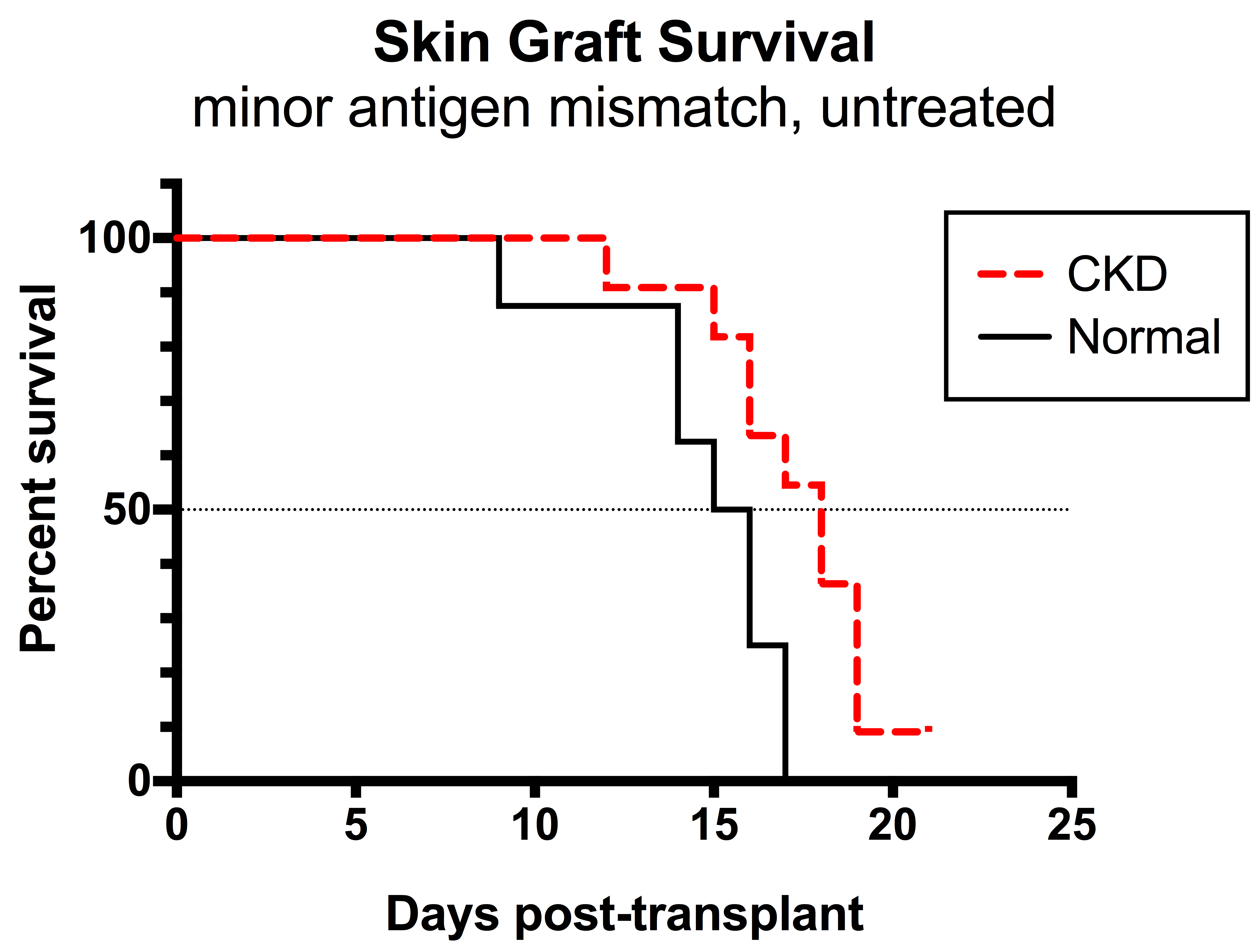Effect of Chronic Kidney Disease on Allo-Immune Response in Mice
1Pediatrics, Emory University School of Medicine, Atlanta, GA, 2Surgery, Emory University School of Medicine, Atlanta, GA
Meeting: 2019 American Transplant Congress
Abstract number: A11
Keywords: Skin transplantation, Survival, T cells
Session Information
Session Name: Poster Session A: Acute Rejection
Session Type: Poster Session
Date: Saturday, June 1, 2019
Session Time: 5:30pm-7:30pm
 Presentation Time: 5:30pm-7:30pm
Presentation Time: 5:30pm-7:30pm
Location: Hall C & D
*Purpose: Accumulation of memory T cells bearing markers of sustained antigen stimulation have been described in patients with chronic kidney disease (CKD). However, mouse models of alloimmunity are typically studied in young, naive animals without chronic disease. We aimed to determine whether CKD alters the T cell repertoire in mice, and represents a variable worthy of consideration in murine models of transplant biology.
*Methods: CKD was induced in male 129X1/SvJ mice (KbDb) through five-sixths nephrectomy (5/6Nx) in a two-stage surgery (n=11). Age-matched mice (n=8) served as controls. Multicolor flow cytometry of peripheral blood at 8 weeks following CKD evaluated expression of PD-1, KLRG1, CD11a, DNAM and TIGIT on total and CD44hi T cells. Untreated graft survival following minor-antigen mismatch skin transplant (C57BL/6J donor) was compared for mice with and without CKD using Mantel Cox log-rank test.
*Results: Mice with CKD had higher pre-transplant frequencies of CD44hi T cells compared to normal mice (14.7% vs 8.9% of CD4+, p=0.001; 12.1% vs 9.2% of CD8+, p=0.001). Circulating CD44hi CD8+ T cells in CKD mice had higher mean fluorescence intensity (MFI) for CD11a (8532 ± 950 vs 7001 ± 474, p<0.001), DNAM (1278 ± 94 vs 1155 ± 45, p=0.003), and TIGIT (1092 ± 202 vs 745 ± 224, p=0.001) compared to normal mice. CD44hi CD4+ T cells from CKD mice displayed a shift from low to high TIGIT MFI (Figure 1) and had increased expression of PD-1 (MFI 2330 ± 114 vs 2010 ± 87, p<0.001) compared to controls. Finally, mice with CKD had longer graft survival (median 18 days) compared to mice with normal kidney function (15.5 days; p=0.01, Figure 2).
Figure 1. TIGIT fluorescence histogram for CD4+CD44hi T cells.
Figure 2. Graft survival following untreated minor mismatch skin transplant
*Conclusions: Mice with CKD accumulate CD44hi T cells with increased expression of the co-inhibitory pathways TIGIT and PD-1 and experienced delayed graft loss compared to normal mice. These data suggest that CKD can promote significant alterations in the immune response independent of age or environmental antigen exposure. The role of altered co-inhibitory pathways on the alloimmune response during CKD is currently being evaluated.
To cite this abstract in AMA style:
Winterberg PD, Li H, Wagener ME, Ford ML. Effect of Chronic Kidney Disease on Allo-Immune Response in Mice [abstract]. Am J Transplant. 2019; 19 (suppl 3). https://atcmeetingabstracts.com/abstract/effect-of-chronic-kidney-disease-on-allo-immune-response-in-mice/. Accessed December 28, 2025.« Back to 2019 American Transplant Congress


